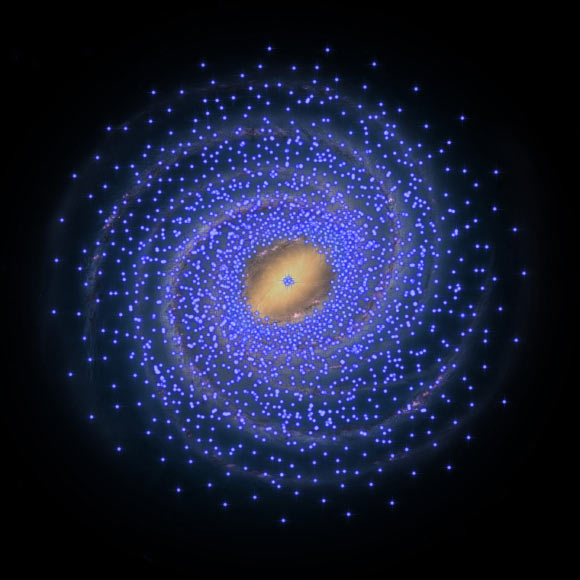An international team of astronomers has found that there is a huge region in the inner part of the Galactic disc that is devoid of stars known as Cepheids.

An artist’s concept of the implied distribution of Cepheids (blue) in the Milky Way. With the exception of a small clump in the Galactic center, the central 8,000 light years appear to have very few Cepheids, and hence very few young stars. Image credit: University of Tokyo.
Our Milky Way Galaxy is a spiral galaxy containing many billions of stars with our Sun about 26,000 light years from its center.
Measuring the distribution of these stars is crucial to our understanding of how the Galaxy formed and evolved.
Variable stars called Cepheids are ideal for this. They are much younger (between 10 and 300 million years old) than the Sun and they pulsate in brightness in a regular cycle.
The length of this cycle is related to the luminosity of the Cepheid, so if astronomers monitor them they can establish how bright the star really is, compare it with what we see from Earth, and work out its distance.
Despite this, finding Cepheids in the inner Milky Way is difficult, as the Galaxy is full of interstellar dust which blocks out light and hides many stars from view.
Dr. Noriyuki Matsunaga from the University of Tokyo and co-authors compensated for this, with an analysis of near-infrared observations made with a Japanese-South African telescope located at Sutherland, South Africa.
To their surprise they found hardly any Cepheids in a huge region stretching for thousands of light years from the core of the Galaxy.
“We already found some while ago that there are Cepheids in the central heart of our Milky Way (in a region about 150 light years in radius),” Dr. Matsunaga said.
“Now we find that outside this there is a huge Cepheid desert extending out to 8,000 light years from the center.”
This suggests that a large part of our Galaxy, called the Extreme Inner Disk, has no young stars.
“Our conclusions are contrary to other recent work, but in line with the work of radio astronomers who see no new stars being born in this desert,” said team member Dr. Michael Feast, from the University of Cape Town and the South African Astronomical Observatory.
“The current results indicate that there has been no significant star formation in this large region over hundreds of millions years,” added co-author Dr. Giuseppe Bono, from the Universita di Roma Tor Vergata and the Osservatorio Astronomico di Roma.
“The movement and the chemical composition of the new Cepheids are helping us to better understand the formation and evolution of the Milky Way.”
The team’s findings were published online June 27 in the Monthly Notices of the Royal Astronomical Society (arXiv.org preprint).
_____
Noriyuki Matsunaga et al. 2016. A lack of classical Cepheids in the inner part of the Galactic disc. MNRAS 462 (1): 414-420; doi: 10.1093/mnras/stw1548







